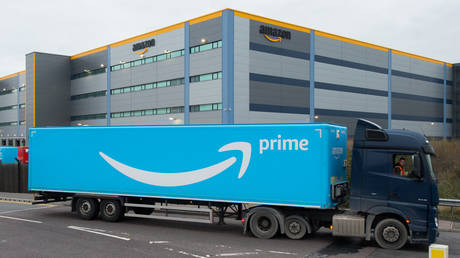
The e-retail behemoth makes unrealistic demands of its contractors, court papers said
Amazon has been accused of imposing “unrealistic expectations” on its drivers with its invasive performance tracking app. The claim was filed by a Virginia man, who lost his leg after a collision with an Amazon delivery truck. He filed a $100 million lawsuit against the e-commerce giant, the latest among dozens of its kind, a local newspaper reported on Monday.
The story, published by The Virginian-Pilot daily, details a lawsuit filed by a man named Justin Hartley last month in Norfolk Circuit Court. The damage claim stems from his ordeal after a traffic incident, which happened in Virginia Beach in early October.
Hartley was riding a motorcycle when a rented Amazon delivery truck turned directly into his lane. He suffered serious fractures in the collision, including to his left leg, which had to be amputated below the knee due to the severity of the injuries. Hartley, who worked as a welder at the time, lost his job and was strapped with “several hundred thousand dollars of medical expenses”, his lawyers told the daily.
The driver of the truck, Christopher Gill, was allegedly looking down at a navigation device when the incident occurred. The lawsuit claims he admitted looking at the device to authorities, though the defense team, representing the driver and Amazon, denied it.
Hartley’s attorney, Kevin Biniazan, said the collision was preventable and that Amazon’s policies, which require drivers to use its Flex App while delivering packages for the company, contributed to the outcome.
The company is notorious for its use of surveillance technology to boost productivity of employees and contractors. The navigation app sets a pace of delivery and nudges drivers who fall “behind the rabbit” – don’t keep up with the schedule – to hurry up.
“The unrealistic expectations that are put on the drivers are fueling these negligence cases,” Biniazan said of incidents similar to the one that the lawsuit argued had stripped Hartley of his livelihood.
The defense team denied negligence by the driver and the assertion that Amazon could be held liable for the incident, citing Gill’s status as a contractor.
The case is one of dozens, in which people seek damages from Amazon for motor incidents involving its delivery vehicles, the newspaper noted, citing a feature story published by Bloomberg last November. The publication said at the time there were at least 119 similar lawsuits across 35 states, in which Amazon Logistics, the company’s delivery arm, was listed as a defendant.
There are court precedents of people winning compensation from a large company for something done by a driver delivering things on its behalf, Bloomberg said. In 1993, a woman from St. Louis received $78 million in punitive damages from Domino’s Pizza after she was seriously injured by a delivery driver working for one of the chain’s franchise holders, who ran a red light and struck her car. The company abandoned its 30-minute delivery guarantee after that.




